Prerequisites
Before you proceed with installing the Robot, we highly recommend checking out the compatibility matrix, as well as the Hardware and Software requirements.
In order to install Unattended Robots, the user under which the Robot runs requires the following:
- To be added to the Remote Desktop Users local group, in Computer Management.
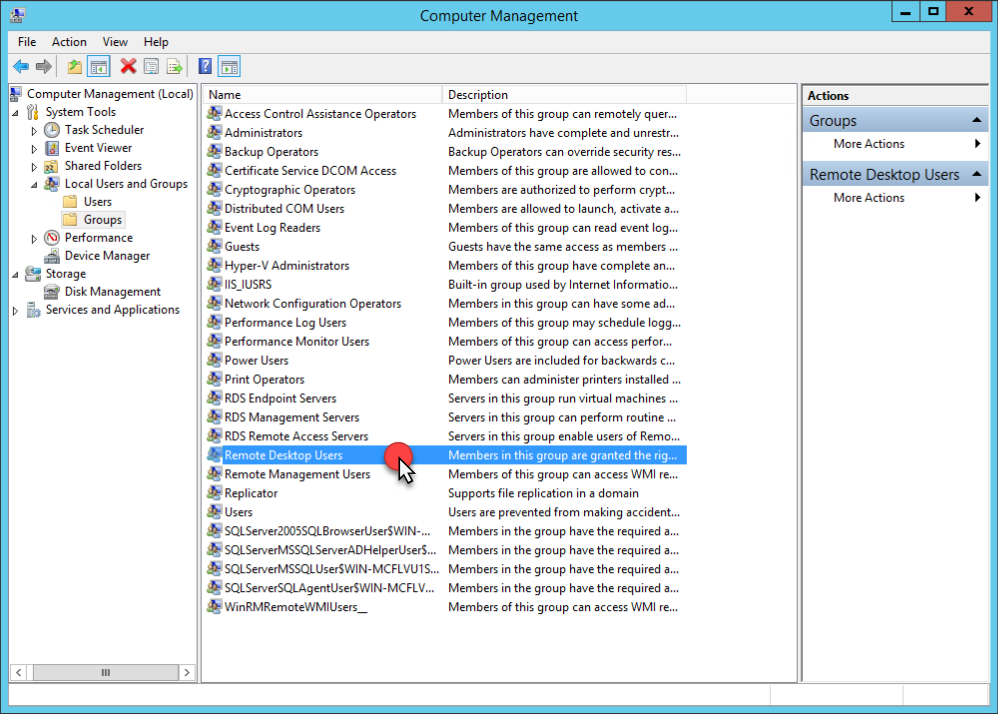
- To have the following user rights, in the Local Computer Policy:
- Allow log on locally
- Access this computer from the network - only for HD Unattended Robots.
- Allow log on through Remote Desktop Services - only for HD Unattended Robots.
Important!
You can add the Remote Desktop Users group to all these rights, as you previously added the user to this group.
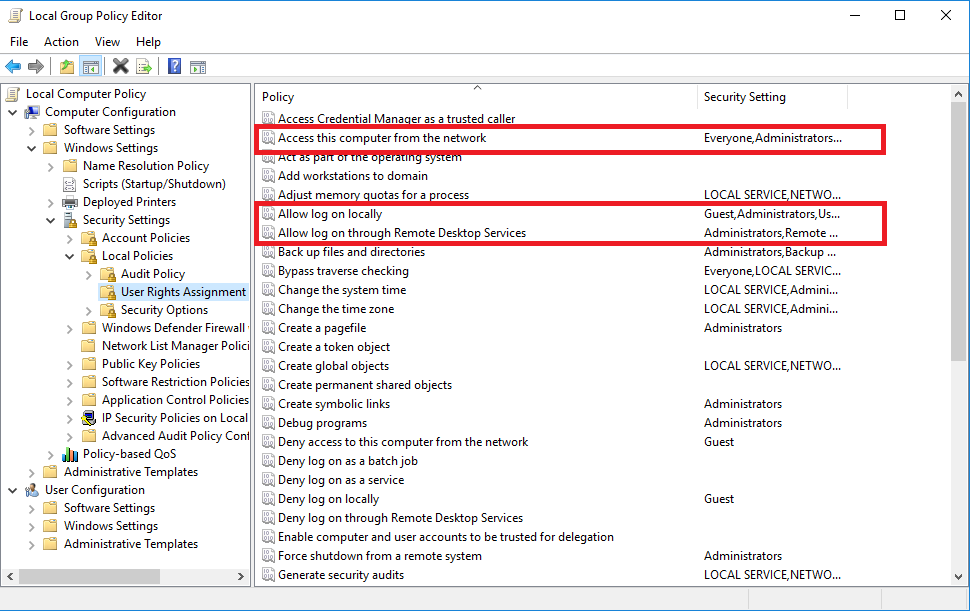
GUI Installation
The Robot can be deployed on a machine using one of the following installers:
UiPathPlatformInstaller.exeUiPathStudio.msiUiPathStudioSetup.exe
Note:
It is NOT supported to have both the User Mode installer (
UiPathStudioSetup.exe) and the Windows installer (UiPathStudio.msi) versions of Studio and the Robot on the same machine.
The installation artifacts are provided when you first purchase a Robot or they can be provided by your customer success manager or our support team.
After reading and accepting the terms of the License Agreement, you can proceed with the installation.
UiPathPlatformInstaller.exe
The UiPathPlatformInstaller.exe file allows you to install the Robot, Studio, and Orchestrator. Administrator rights are required for installation. Please note that this file does not accept command line arguments.
By default, the Robot is installed in the C:\Program Files (x86)\UiPath\Studio directory, but you can change it by adding a custom path in the Installation Path field.
Agent Desktop is automatically installed. You can access it from the C:\Program Files (x86)\UiPath\Studio\AgentDesktop directory, or the UiPath Agent Desktop app from the Start Menu.
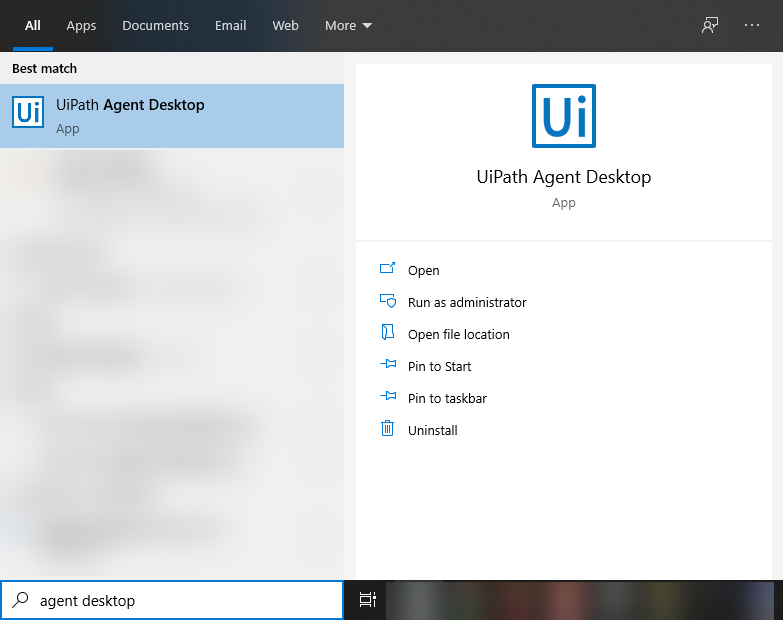
From the Products section, you need to choose the component you want to install.
- Install UiPath Robot Only - Recommended if you only need to execute automation projects on that machine.
- Install UiPath Studio + Robot - The default option. Recommended if you want to both design and execute automation projects on that machine.
From the Installation Type section, you need to choose the type of Robot you want to install.
- Service Mode - recommended for unattended automation scenarios and large-scale platform deployments, and runs with the same rights as the user under which it is registered.
- User Mode - recommended for attended automation scenarios, and runs under the user that installed it, having the exact rights as that particular user.
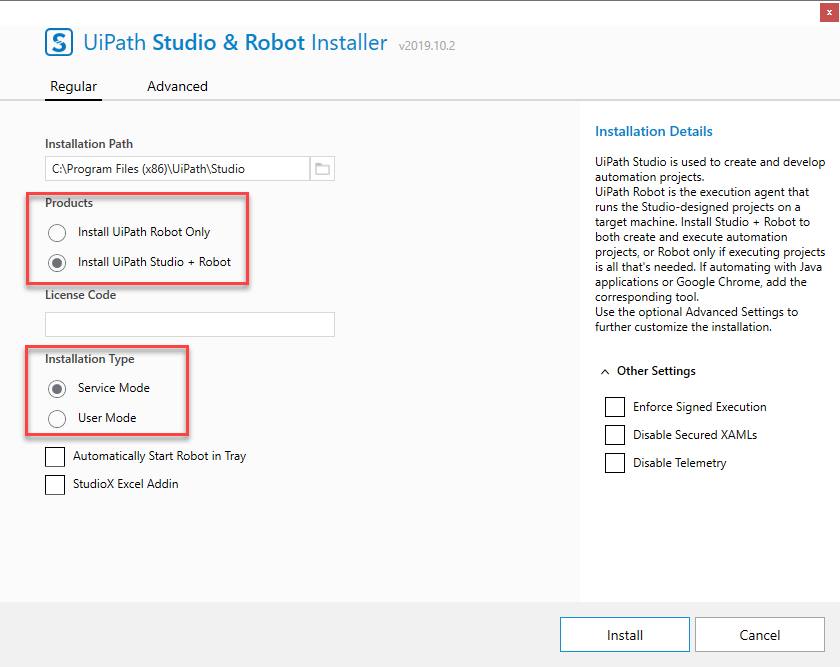
Additional Options
The installation can be further customized with some additional options.
- Other Settings:
- Enable Signed Execution - If selected, only signed packages can be installed and executed. Read more about signing and verifying packages.
- Disable Secured XAMLs - If selected, no security for process
.xamlfiles is used, meaning users are allowed to read and modify the process files and logic. - Disable Telemetry - If selected, UiPath will not collect any usage or performance data. Read more about Opting Out of Telemetry.
In the Regular tab, the following options are available:
- License Code - Optional. Allows you to add your stand-alone trial or enterprise license key, if available. If left blank, you are prompted to activate Studio when it is first launched.
- Automatically Start Robot in Tray - If selected, the Robot is launched automatically after the installation is completed.
- StudioX Excel Addin - Select to also install the integration addin for StudioX and Microsoft Excel.
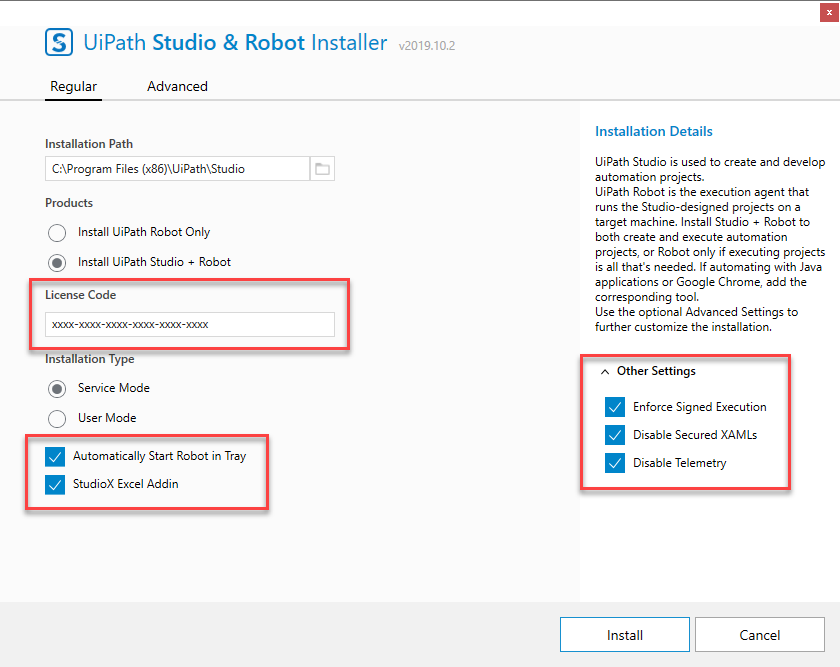
In the Advanced tab, the following options are available:
- Tools - Use the checkboxes to also install the extensions for Java, Chrome, or Citrix. Read more about extensions here.
- Orchestrator Connection String - Provide the connection string to automatically connect your robot(s) to Orchestrator. More details here.
- Custom Packages Path - Enables you to provide a custom download location for your workflows and dependencies for UiPath Studio and Robot. By default, these are saved to
%ProgramFiles(x86)%\UiPath\Studio\Packages. - Packages Configuration - Select whether to Install Local Activities (enabled by default), or to Disable Online Feeds of activities. Learn more About the Activities Feeds.
- Custom NuGet Feeds - Use the Feed Name and Feed URL fields to add any custom NuGet feed to the installation.
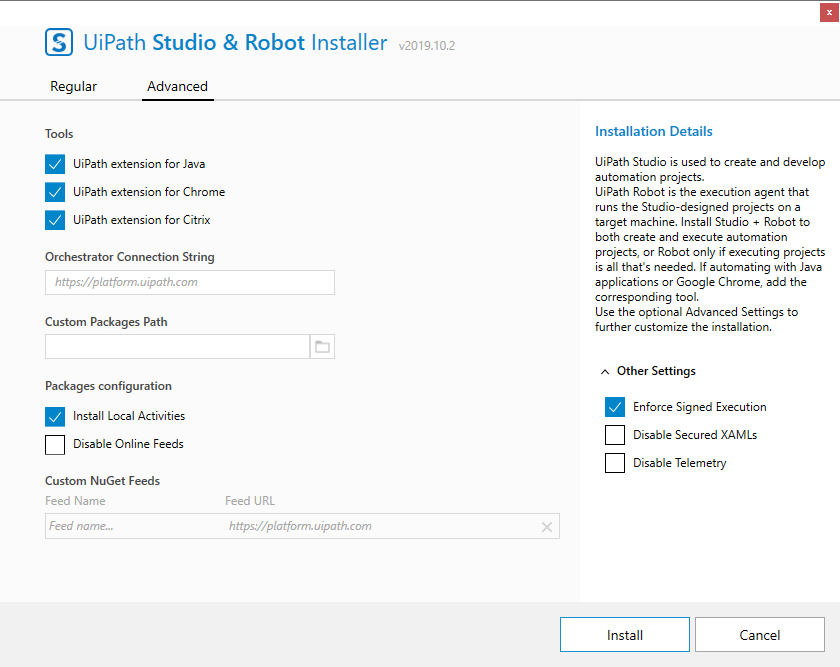
UiPathStudio.msi
The UiPathStudio.msi file allows you to install the Robot and Studio. Administrator rights are required for installation. Command Line Arguments can be used with this file.
This file installs the Robot in the C:\Program Files (x86)\UiPath\Studio directory. It can only be changed with command line arguments.
Clicking the Advanced button in the installer opens the Product Features window, which allows you to choose the components you want to install.
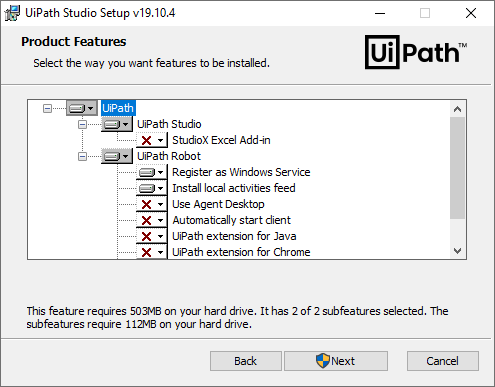
By default, Studio and Robot are installed. This is recommended if you want to both design and execute automation projects on that machine.
If you only want to install the Robot, click the  button next to the UiPath Studio feature and select the Entire feature will be unavailable option.
button next to the UiPath Studio feature and select the Entire feature will be unavailable option.

The Service Mode Robot is installed by default. This is recommended for unattended automation scenarios and large-scale platform deployments, and runs with the same rights as the user under which it is registered.
If you want to install the User Mode Robot, click the  button next to the Register as Windows Service feature and select the Entire feature will be unavailable option.
button next to the Register as Windows Service feature and select the Entire feature will be unavailable option.

To install an additional feature, click the  button next to it and select the Will be installed on the local hard drive option.
button next to it and select the Will be installed on the local hard drive option.

The following additional features can be installed:
- Install local activities feed - Creates the local activities feed, in the
C:\Program Files (x86)\UiPath\Studio\Packagesfolder, by default. This option is enabled by default. Having the activities packages locally is useful if you do not intend to connect your Robot to Orchestrator, or you want to have better control of the activities used in an automation project. Check out the list of default activities packages here. - Use Agent Desktop - Starts Agent Desktop instead of the Robot Tray when the Robot is launched. It is recommended for a better attended automation experience.

- Automatically start client - Starts the Robot Tray at Windows startup. This option is disabled by default.
- UiPath extension for Java - Installs the UiPath extension for Java for a better integration and automation in regards to Java applications. This option is disabled by default. Please note that installing the Java Bridge may cause the installation to last longer than usual. This option installs the Java Bridge only in the system drive Java folders. If you are using custom JRE not located on the system drive, you have to manually install it with the ScreenScrapeJavaSupport Tool.
- UiPath extension for Chrome - Installs the UiPath extension for Chrome needed for automating processes in Chrome. This option is disabled by default.
- UiPath extension for Citrix - Installs the UiPath extension for Citrix for creating automation projects for Citrix Apps natively. This option is disabled by default.
If you want to install the Robot and all its sub-features, click the  button next to the UiPath Robot feature and select the Entire feature will be installed on the local hard drive option.
button next to the UiPath Robot feature and select the Entire feature will be installed on the local hard drive option.
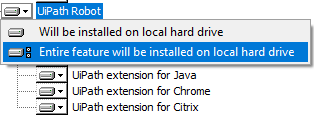
UiPathStudioSetup.exe
The UiPathStudioSetup.exe file allows you to install Studio and a User Mode Robot. The installation path is %localappdata%\UiPath, and all other advanced options are already configured to help you get Studio up and running right away.
Note:
The User Mode installer (
UiPathStudioSetup.exe) does not require administrator rights, meaning that it is installed per user and is limited to the rights that the user has.
Command Line Installation
Studio and Robot can also be installed using command line arguments with the UiPathStudio.msi file. Administrator rights are required for command line installation. Installing Orchestrator with command line arguments is done with the UiPathOrchestrator.msi file.
Updated 2 years ago
See Also
| Hardware Requirements |
| Software Requirements |
| Licensing a Robot |
| Setting Up Windows Server for High-Density Robots |